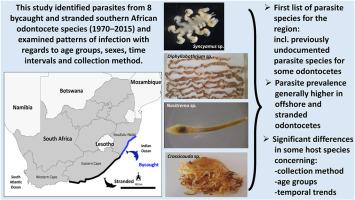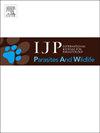南非东南部8种齿齿动物的长期寄主寄生虫动态
IF 2.2
3区 医学
Q3 ECOLOGY
International Journal for Parasitology-Parasites and Wildlife
Pub Date : 2025-09-05
DOI:10.1016/j.ijppaw.2025.101133
引用次数: 0
摘要
尽管自20世纪70年代以来就对搁浅和被捕获的鲸类进行了调查,但对在南非分区域发现的25种鲸类感染寄生虫的情况知之甚少。在这项研究中,我们回顾性地鉴定了1970年至2015年期间南非东南海岸8种被捕获和搁浅的齿齿鲸物种的寄生虫,以产生影响南部非洲齿齿鲸的寄生虫物种清单,并检查宿主物种在年龄、性别、时间间隔和收集方法方面的感染模式。在2599个被检查的个体中,有192个被鉴定出寄生虫。在几个南部非洲齿齿动物物种中发现了以前未报道的寄生虫物种,强调了博物馆收藏对生物学研究的重要性。尽管有少数例外,但近海和搁浅齿螈的寄生虫普遍较高。二项logistic回归模型显示,搁浅的三角海豚的寄生虫存在概率显著高于被捕获的个体(p < 0.05),而搁浅的aduncus和蓝纹蝶幼崽的寄生虫存在概率显著低于成虫(p < 0.05)。所调查齿齿鼠种的性别差异无统计学意义(p > 0.05)。在最近几年(2000-2015年)调查的一半齿齿动物中,寄生虫流行率最高,这与模型一致。对影响海洋哺乳动物的寄生虫进行准确的形态学鉴定,对于理解疾病流行病学、评估鲸类种群的健康状况以及制定有效的保护和管理策略至关重要。本文章由计算机程序翻译,如有差异,请以英文原文为准。

Long-term host parasite dynamics in eight odontocete species from south-eastern South Africa
Although investigations of stranded and bycaught cetaceans have been conducted since the 1970s, little is known about parasites infecting the 25 species found in the South African subregion. For this study, we retrospectively identified parasites from eight bycaught and stranded odontocete species along the south-eastern coast of South Africa between 1970 and 2015 to produce a list of parasite species affecting southern African odontocetes and examine patterns of infection in host species with regards to age, sex, time intervals and collection method. Parasites were identified in 192 out of the 2599 individuals examined. Previously unreported parasite species were found for several southern African odontocete species, underscoring the importance of museum collections for biological research. Offshore and stranded odontocetes generally had a higher prevalence of parasites, although there were a few exceptions. Binomial logistic regression models showed significantly higher probability of parasitic presence (p < 0.05) in stranded Delphinus delphis than bycaught individuals, and significantly lower probability of parasitic presence (p < 0.05) in neonates and calves of stranded Tursiops aduncus and Stenella coeruleoalba than adult animals. No significant difference (p > 0.05) was detected between the sexes of all odontocete species investigated (p > 0.05). Parasitic prevalence was highest during the most recent years (2000–2015) for half of the odontocete species investigated, in agreement with the models. Accurate morphological identification of parasites affecting marine mammals is essential for comprehending disease epidemiology, assessing the health of cetacean populations, and developing effective conservation and management strategies.
求助全文
通过发布文献求助,成功后即可免费获取论文全文。
去求助
来源期刊

International Journal for Parasitology-Parasites and Wildlife
Medicine-Infectious Diseases
CiteScore
3.80
自引率
5.60%
发文量
113
审稿时长
45 days
期刊介绍:
The International Journal for Parasitology: Parasites and Wildlife (IJP-PAW) publishes the results of original research on parasites of all wildlife, invertebrate and vertebrate. This includes free-ranging, wild populations, as well as captive wildlife, semi-domesticated species (e.g. reindeer) and farmed populations of recently domesticated or wild-captured species (e.g. cultured fishes). Articles on all aspects of wildlife parasitology are welcomed including taxonomy, biodiversity and distribution, ecology and epidemiology, population biology and host-parasite relationships. The impact of parasites on the health and conservation of wildlife is seen as an important area covered by the journal especially the potential role of environmental factors, for example climate. Also important to the journal is ''one health'' and the nature of interactions between wildlife, people and domestic animals, including disease emergence and zoonoses.
 求助内容:
求助内容: 应助结果提醒方式:
应助结果提醒方式:


